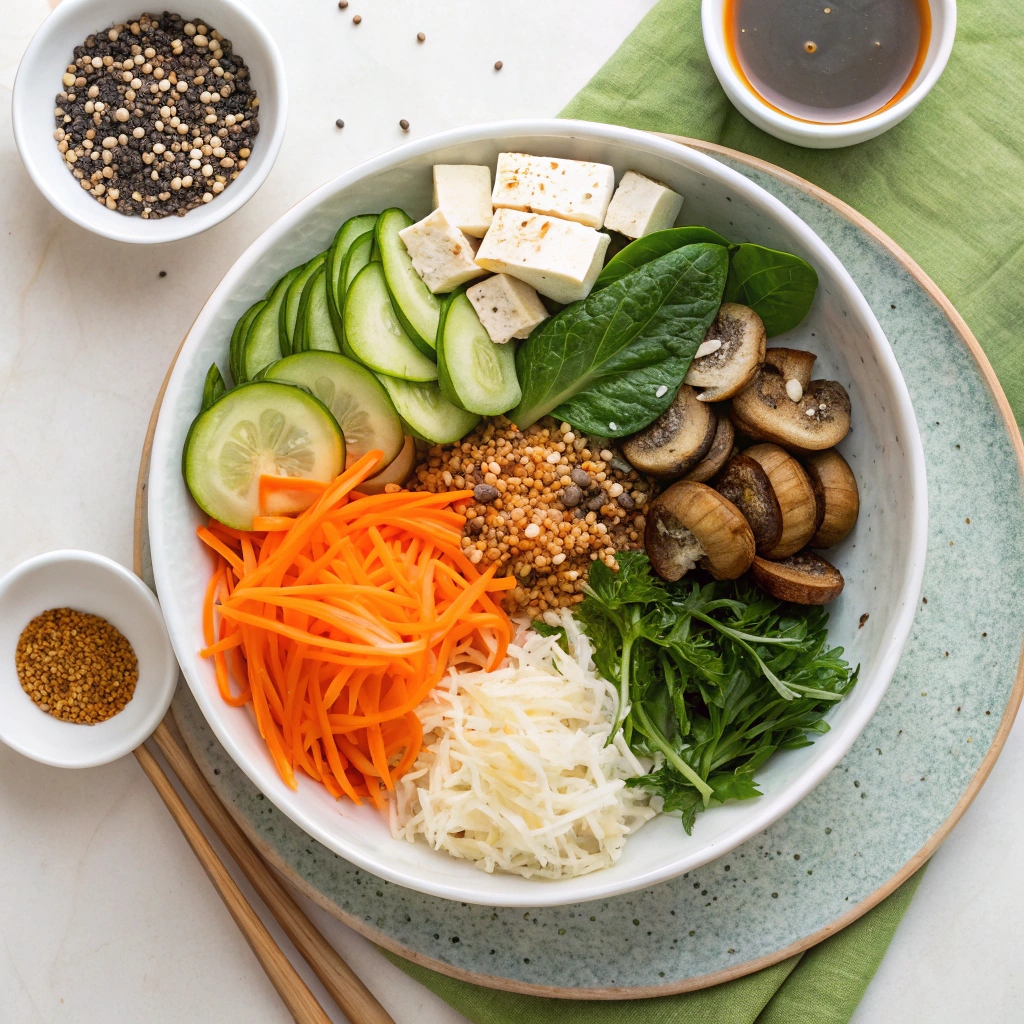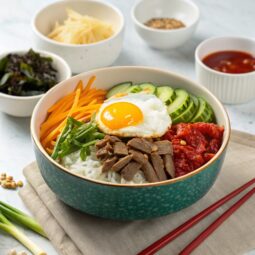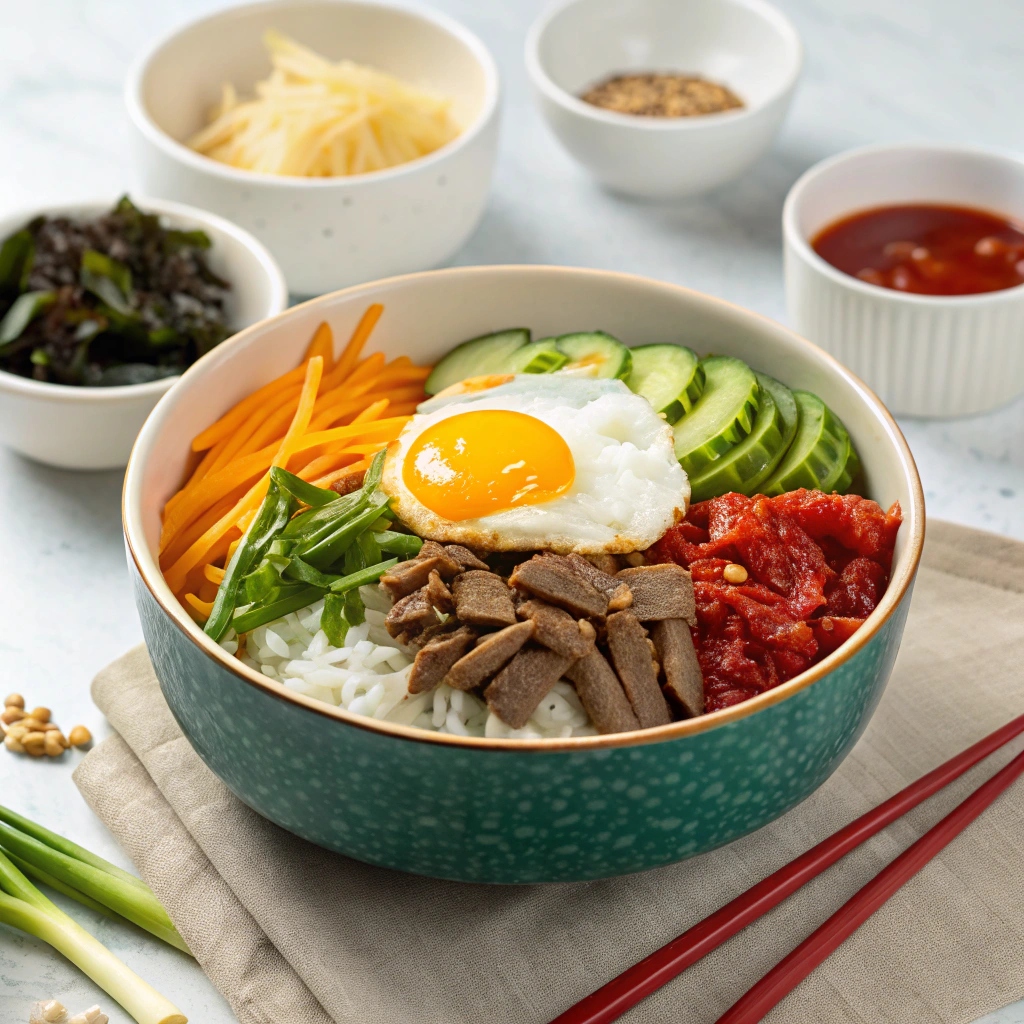Bibimbap is a vibrant Korean dish that brings together a symphony of flavors and textures in every bite. Crisp, fresh vegetables mingle with savory marinated beef, all crowned by a perfectly fried egg.
The dish is a feast for the senses, offering a delightful contrast of crunchy, tender, and creamy elements. With just 40 minutes from start to finish, it’s a quick yet impressive meal that feels both nourishing and indulgent.
What makes bibimbap truly special is its versatility and balance. Each ingredient shines on its own, yet they harmonize beautifully when mixed with the spicy, tangy gochujang sauce. The warm rice base ties everything together, creating a comforting yet exciting dish.
Whether you’re new to Korean cuisine or a seasoned fan, this recipe is a flavor-packed adventure that’s as fun to make as it is to eat.
Ingredients for Bibimbap

- Vegetables:
- ½ English cucumber, thinly sliced
- 1 cup fresh mung bean sprouts
- 1 cup shredded carrots
- 4 cups baby spinach
- 4 ounces sautéed shiitake mushrooms (optional)
- Seasonings & Sauces:
- ½ teaspoon rice vinegar
- 1¼ teaspoons toasted sesame oil (divided)
- ½ teaspoon tamari (or soy sauce)
- 1 recipe Gochujang Sauce (store-bought or homemade)
- Sea salt (to taste)
- Sesame seeds (for garnish)
- Base & Protein:
- 2 cups cooked short-grain white rice
- 2 fried eggs (or 1 cup cubed baked tofu for a vegan option)
- Optional Toppings:
- Kimchi (for serving)
- Chopped scallions (for garnish)
Step-by-Step Instructions
- Prepare the Cucumber: In a small bowl, toss the cucumber slices with rice vinegar, ¼ teaspoon sesame oil, and a pinch of salt. Set aside to marinate.
- Blanch the Bean Sprouts: Bring a small pot of water to a boil. Add the bean sprouts and cook for 1 minute. Drain and set aside.
- Sauté the Carrots: Heat ½ teaspoon sesame oil in a medium skillet over medium heat. Add the shredded carrots and a pinch of salt. Cook, stirring, for 1-2 minutes until slightly softened. Remove and set aside.
- Wilt the Spinach: In the same skillet, heat the remaining ½ teaspoon sesame oil. Add the spinach and tamari. Cook, tossing, for 30 seconds until just wilted. Remove from the skillet and gently squeeze out any excess water.
- Assemble the Bowls: Divide the cooked rice into serving bowls. Arrange the marinated cucumber, blanched bean sprouts, sautéed carrots, and wilted spinach around the rice.
- Add Protein: Top each bowl with a fried egg or baked tofu. Add sautéed shiitake mushrooms if using.
- Garnish & Serve: Sprinkle with sesame seeds and drizzle generously with Gochujang Sauce. Serve with kimchi and chopped scallions on the side, if desired. Enjoy!
Customize Your Bibimbap with Creative Toppings
While the classic bibimbap toppings are delicious, feel free to get creative! Try adding sliced avocado, pickled radishes, or roasted sweet potatoes for extra flavor and texture. For a protein boost, consider grilled chicken, marinated beef, or pan-seared shrimp. The possibilities are endless!
Perfect Pairings for Your Bibimbap Bowl
Bibimbap is a complete meal on its own, but it pairs wonderfully with kimchi for a tangy kick or a side of miso soup for a comforting touch. If you’re serving a crowd, add a refreshing cucumber salad or a light seaweed salad to round out the meal.
Quick Tips for Speedy Bibimbap Prep
Save time by prepping ingredients in advance. Cook the rice and chop the veggies the night before, and store them in airtight containers. Use pre-sliced mushrooms or bagged spinach to cut down on prep time. For a shortcut, swap homemade gochujang sauce with a store-bought version.
How to Store and Reheat Your Bibimbap?
Store leftover bibimbap in an airtight container in the fridge for up to 2 days. To reheat, place the rice and toppings in a skillet over medium heat, adding a splash of water to prevent drying out. Alternatively, microwave in 30-second intervals, stirring in between, until warmed through.
Make It Your Own: Bibimbap Variations
Experiment with different grains like brown rice, quinoa, or cauliflower rice for a healthier twist. Swap out the gochujang sauce for a spicy peanut sauce or a sesame ginger dressing if you prefer a milder flavor. For a vegan version, skip the egg and double up on the baked tofu or add tempeh.

Bibimbap
Ingredients
- ½ English cucumber, thinly sliced
- ½ teaspoon rice vinegar
- 1¼ teaspoons toasted sesame oil
- 1 cup fresh mung bean sprouts
- 1 cup shredded carrots
- 4 cups baby spinach
- ½ teaspoon tamari
- 2 cups cooked short-grain white rice
- 2 fried eggs, or 1 cup cubed baked tofu
- 4 ounces sautéed shiitake mushrooms, optional
- 1 recipe Gochujang Sauce
- Sesame seeds
- Sea salt
- Kimchi, optional, for serving
- Chopped scallions, optional, for serving
Instructions
- In a small bowl, toss the cucumber slices with the rice vinegar, ¼ teaspoon of the sesame oil, and a pinch of salt. Set aside.
- Bring a small pot of water to a boil. Drop in the bean sprouts and cook for 1 minute. Drain and set aside.
- Heat another ½ teaspoon of the sesame oil in a medium skillet over medium heat. Add the carrots and a pinch of salt. Cook, stirring, for 1 to 2 minutes, or until a little bit soft, and then remove from the pan and set aside.
- Heat the remaining ½ teaspoon sesame oil in the skillet and add the spinach and tamari. Cook, tossing, for 30 seconds, or until just wilted. Remove from the skillet and gently squeeze out any excess water from the spinach.
- Assemble the bowls with the rice, cucumber slices, bean sprouts, carrots, and spinach. Top with a fried egg or baked tofu. Add the mushrooms, if using. Sprinkle with sesame seeds and drizzle generously with the gochujang sauce. Serve with kimchi and scallions, if desired, and the remaining gochujang sauce on the side.

